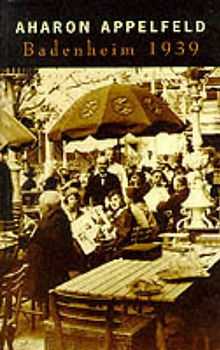Badenheim 1939
 | |
| Author | Aharon Appelfeld |
|---|---|
| Original title | באדנהיים עיר נופש (translit.: Badenhaim `ir nofesh) |
| Translator | Dalya Bilu |
| Country | Israel |
| Language | Hebrew |
| Genre | Allegorical, Satire, Historical novel |
| Publisher | David R. Godine (translation) |
Publication date | 1978 |
Published in English | November 1980 |
| Media type | Print (Hardback & Paperback) |
| Pages | 148 pp (Hardback English-language edition) |
| ISBN | ISBN 0-87923-342-7 (translation hardback edition) & ISBN 0-7043-8026-9 (translation paperback edition) |
| OCLC | 6603140 |
| 892.4/36 19 | |
| LC Class | PJ5054.A755 B3413 1980 |
Badenheim 1939 is an Israeli novel by Aharon Appelfeld. First published in Hebrew in 1978 as באדנהיים עיר נופש (Badenhaim `ir nofesh, 'resort town Badenheim'), it was his first novel to be translated into English, and was subsequently translated into many other languages. Described as "the greatest novel of the Holocaust",[1] this novel is an allegorical satire that tells the story of a fictional Jewish town in Austria shortly before its residents are relocated to Nazi concentration camps in German occupied Poland.[2]
In 2010, a stage version of the novel was first staged, written by Sir Arnold Wesker with music by Julian Phillips, at the Guildhall School of Music & Drama in London in November 2010.[3]
Plot summary
Badenheim is a primarily Jewish resort town in Austria that hosts a yearly arts festival, organized by Dr. Pappenheim. Slowly, the Nazi regime, represented by the "Sanitation Department", begins shutting down the town and preparing to move its residents to Eastern Europe. The citizens begin blaming each other and losing their minds. Despite impending doom, others remain optimistic and refuse to see the coming Holocaust.
Characters in Badenheim 1939
- Dr. Pappenheim
- an optimistic and eccentric impresario who visits Badenheim each summer to organize the annual music festival. He craves structure, constantly refers to schedules and timetables, but is always able to find positive explanations for the most ominous of actions.
- Frau Zauberblit
- an escapee from a nearby sanatorium, she appears to have mild symptoms of tuberculosis. In her gay straw hat, she enjoys the companionship and culture that Badenheim provides.
- Martin
- the local pharmacist, is self-conscious and quick to blame himself for the problems of others. He is dedicated to his ailing wife, Trude.
- Trude
- Martin’s wife; stricken with severe depression and paranoia; she constantly awaits news from her daughter.
- Sally and Gertie
- two local middle-aged prostitutes, largely accepted by the community.
- Mandelbaum
- an eccentric musician who arrives late in the season along with a musical trio.
- Dr. Shutz
- a boyish, love-starved doctor who is in love with a visiting schoolgirl who he soon learns is pregnant.
- Dr. Langmann
- claiming his Austrian heritage with pride, he is quick to denounce his Judaism in order to maintain his status.
- Karl and Lotte
- a couple who journey to Badenheim for the music festival. Karl has dragged a skeptical Lotte to the town, but it is Karl who loses his grip on reality as the summer wears on.
- Leon Samitzky
- a musician who migrated from Poland as a child and still recalls his native land with fondness.
- The yanuka
- Nahum Slotzker, a polish child and musical prodigy brought to Badenheim by Dr. Pappenheim. (“Yanuka” is an Aramaic word meaning “child prodigy,” often used to describe very young and very bright Talmudic scholars.).
- The rabbi
- old, infirm and forgotten, he appears in his wheelchair very late in the novel, lamenting in an incomprehensible mixture of Yiddish and Hebrew.
References
- ↑ Linda Grant (2004-01-30). "In the zone of the living". The Guardian. Retrieved 2014-11-01.
- ↑ Hepzibah Anderson (2005-08-21). "One Man's Road to Freedom". The Observer. Retrieved 2014-11-01.
- ↑ Dan Carrier (2010-11-04). "Feature: Theatre - Based on Aharon Appelfeld's allegorical Holocaust play, Badenheim 1939 -Sir Arnold Wesker's version is at the Guildhall School of Music and Drama’s Silk Street Theatre". Camden New Journal. Retrieved 2014-11-01.